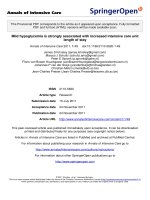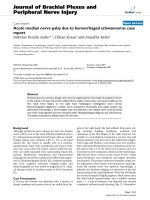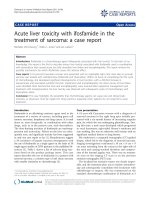Báo cáo y học: "Acute kidney injury on admission to the intensive care unit: where to go from here" docx
Bạn đang xem bản rút gọn của tài liệu. Xem và tải ngay bản đầy đủ của tài liệu tại đây (67.99 KB, 2 trang )
Open Access
Available online />Page 1 of 2
(page number not for citation purposes)
Vol 12 No 6
Commentary
Acute kidney injury on admission to the intensive care unit: where
to go from here?
Marlies Ostermann
Guy's and St Thomas Hospital, Department of Critical Care, Westminster Bridge Road, London SE1 7EH, UK
Corresponding author: Marlies Ostermann,
Published: 7 Nov 2008
Critical Care 2008, 12:189 (doi:10.1186/cc7096)
This article is online at: />© 2008 BioMed Central Ltd
See related research by Kolhe et al., />Abstract
Acute kidney injury (AKI) is a common problem, especially in
critically ill patients. In Critical Care, Kolhe and colleagues report
that 6.3% of 276,731 patients in 170 intensive care units (ICUs)
in the UK had evidence of severe AKI within the first 24 hours of
admission to ICU. ICU and hospital mortality as well as length of
stay in hospital were significantly increased. In light of this
serious burden on individuals and the health system in general,
the following commentary discusses the current state of
knowledge of AKI in ICU and calls for more attention to
preventive strategies.
Acute kidney injury (AKI) has been the focus of numerous pub-
lications and research projects in the past 5 years [1-4],
including the study by Kolhe and colleagues [1] in Critical
Care. Interestingly, as facts about AKI and its impact on prog-
nosis emerged, areas of uncertainty and controversy became
apparent [5,6]. It is now well known that AKI affects a large
number of patients (although the exact incidence is variable),
that AKI per se is associated with an increased risk of death,
and that patients who need renal replacement therapy (RRT)
have a higher risk of dying [2-4,7,8]. There is also evidence
that AKI is a dynamic process, with many patients progressing
through different stages of severity, and that early AKI appears
to have a better prognosis than late AKI [7]. Numerous studies
have identified factors that influence the prognosis of patients
with AKI, including inherent patient characteristics as well as
modifiable factors (ie, nephrotoxic drugs, fluid status, haemo-
dynamics) and non-patient related aspects like size of ICU and
type of hospital [2-4].
Despite this progress, several areas in the field of AKI remain
uncertain, the issue of RRT being a particularly controversial
one [5]. There is wide variation in clinical practice regarding
mode, indication, timing, dose and provision of RRT [9].
Despite a widely held perception that a continuous mode may
be better for critically ill patients with AKI, especially those with
haemodynamic instability, clinical studies have failed to show
a consistent survival advantage for patients on continuous
RRT compared to intermittent haemodialysis [10]. The Hemo-
diafe Study (randomized controlled trial comparing intermittent
haemodialysis with continuous haemodiafiltration in 21 cen-
tres in France) not only showed similar mortality rates in both
groups but also confirmed that nearly all patients with AKI as
part of multiple-organ dysfunction syndrome could be treated
with intermittent haemodialysis provided strict guidelines were
used to achieve tolerance and metabolic control [11].
In a landmark study, Ronco and colleagues [12] made a strong
case for dosing RRT (the more the better). However, when
challenged in subsequent studies, this conclusion could not
always be confirmed. Most recently, the Acute Renal Failure
Trial Network study demonstrated in a randomized controlled
multicenter fashion that intensive renal support in critically ill
patients with AKI did not decrease mortality, improve recovery
of kidney function or reduce the rate of non-renal organ failure
compared to less intensive therapy [13].
In view of these uncertainties about 'best clinical practice' it is
not surprising that the mortality associated with AKI in critically
ill patients has not substantially changed during the past few
decades despite increasing international efforts and advances
in medical knowledge [14]. Lack of a uniform definition for AKI
and lack of evidence-based guidelines have been blamed for
AKI: acute kidney injury; ICU: intensive care unit; RRT: renal replacement therapy.
Critical Care Vol 12 No 6 Ostermann
Page 2 of 2
(page number not for citation purposes)
some of the inconsistencies and poor progress. Formation of
the international AKI network group, design of the RIFLE crite-
ria and later the AKI classification and plans for streamlined
focussed research are major steps in the right direction to
tackle the problems associated with established AKI [6].
The study by Kolhe and colleagues in Critical Care illustrates
that we may need to focus our attention also on the time
before AKI has developed. Kolhe and colleagues show that
6.3% of 276,731 patients admitted to 170 ICUs in the UK dur-
ing a 10 year period had evidence of severe AKI (serum creat-
inine ≥ 300 μmol/L and/or urea ≥ 40 mmol/L) during the first
24 hours in ICU [1]. Their ICU and hospital mortality as well as
stay in hospital were significantly increased. Moreover, among
survivors, requirement for in-hospital care was even higher.
The study also showed that a perfect mortality prediction
model is still missing. As addressed by the authors, the study
has some weaknesses (arbitrary definition of severe AKI,
potential risk that some patients classified as AKI in fact had
advanced chronic kidney disease, and no information on the
number of patients treated with RRT). However, there are
important messages: 6.3% of all ICU patients were admitted
with severe derangement of renal function. The exact reasons
for renal dysfunction are not given and may not be known but
the question remains whether AKI could have been prevented
prior to transfer to ICU. Chertow and colleagues [15] previ-
ously showed that even small changes in serum creatinine by
≥ 0.3 mg/dL (≥ 26 μmol/L) whilst in hospital were independ-
ently associated with an increased risk of dying. Given the seri-
ous implications of any degree of AKI on the individual and the
health system, and the lack of curative therapies for AKI, it may
be necessary to shift our attention more to the actual way we
look after patients at risk of AKI, that is, how we recognise
high-risk patients and prevent AKI. This call for 'attention to
basics' includes general measures like education and training
of nursing and medical staff, emphasis on the importance of
the clinical examination, attention to drugs, drug dosing and
nutrition, and early consultation with specialists in the field.
The success of these simple non-technical steps depends on
combined efforts by anybody looking after patients in hospital.
The overall action plan to reduce the burden of AKI needs to
incorporate these preventive strategies as well as regular
review of clinical practice, in parallel with international collab-
oration and focussed research into drug therapies and tech-
nologies.
Competing interests
The author declares that they have no competing interests.
References
1. Kolhe NV, Stevens PE, Crowe AV, Lipkin GW, Harrison DA: Case
mix, outcome and activity for patients with severe acute kidney
injury during the first 24 hours after admission to an adult gen-
eral critical care unit: application of predictive models from a
secondary analysis of the ICNARC Case Mix Programme Data-
base. Crit Care 2008, 12(Suppl 1):S2.
2. Uchino S, Kellum JA, Bellomo R, Doig GS, Morimatsu H, Morgera
S, Schetz M, Tan I, Bouman C, Macedo E, Gibney N, Tolwani A,
Ronco C, Beginning and Ending Supportive Therapy for the Kid-
ney (BEST Kidney) Investigators: Acute renal failure in critically
ill patients: a multinational, multicenter study. JAMA 2005,
294:813-818.
3. Ostermann M, Chang RW: Acute kidney injury in the intensive
care unit according to RIFLE. Crit Care Med 2007,
35:1837-1843.
4. Mehta RL, Pascual MT, Soroko S, Savage BR, Himmelfarb J, Ikizler
TA, Paganini EP, Chertow GM, for the Program to Improve Care in
Acute Renal Disease (PICARD): Spectrum of acute renal failure
in the intensive care unit: the PICARD experience. Kidney Int
2004, 66:1613-1621.
5. Gibney N, Hoste E, Burdmann EA, Bunchman T, Kher V, Viswa-
nathan R, Mehta RL, Ronco C: Timing of initiation and discontin-
uation of renal replacement therapy in AKI: unanswered key
questions. Clin J Am Soc Nephrol 2008, 3:876-880.
6. Kellum JA, Mehta RL, Levin A, Molitoris BA, Warnock DG, Shah
SV, Joannidis M, Ronco C, Acute Kidney Injury Network (AKIN):
Development of a clinical research agenda for acute kidney
injury using an international interdisciplinary three-step modi-
fied Delphi process. Clin J Am Soc Nephrol 2008, 3:887-894.
7. Hoste EA, Clermont G, Kersten A, Venkataraman R, Angus DC, De
Bacquer D, Kellum JA: RIFLE criteria for acute kidney injury are
associated with hospital mortality in critically ill patients: a
cohort analysis. Crit Care 2006, 10:R73.
8. Metnitz PGH, Krenn CG, Steltzer H, Lang T, Ploder J, Lenz K, Le
Gall JR, Druml W: Effect of acute renal failure requiring renal
replacement therapy on outcome in critically ill patients. Crit
Care Med 2002, 30:2051-2058.
9. Ricci Z, Ronco C, D'Amico G, DeFelice R, Rossi S, Bolgan I,
Bonello M, Zamperetti N, Petras D, Salvatori G, Dan M, Piccinni P:
Practice patterns in the management of acute renal failure in
the critically ill patient: an international survey. Nephrol Dial
Transplant 2006, 21:690-696.
10. Rabindranath K, Adams J, Macleod AM, Muirhead N: Intermittent
versus continuous renal replacement therapy for acute renal
failure in adults. Cochrane Database Syst Rev 2007,
3:CD003773.
11. Vinsonneau C, Camus C, Combes A, Costa de Beauregard MA,
Klouche K, Boulain T, Pallot JL, Chiche JD, Taupin P, Landais P,
Dhainaut JF, Hemodiafe Study Group: Continuous venovenous
haemodiafiltration versus intermittent haemodialysis for acute
renal failure in patients with multiple-organ dysfunction syn-
drome: a multicentre randomised trial. Lancet 2006,
368:379-385.
12. Ronco C, Bellomo R, Homel P, Brendolan A, Dan M, Piccinni P, La
Greca G: Effects of different doses in continuous veno-venous
haemofiltration on outcomes of acute renal failure: a prospec-
tive randomised trial. Lancet 2000, 356:26-30.
13. VA/NIH Acute Renal Failure Trial Network, Palevsky PM, Zhang JH,
O'Connor TZ, Chertow GM, Crowley ST, Choudhury D, Finkel K,
Kellum JA, Paganini E, Schein RM, Smith MW, Swanson KM,
Thompson BT, Vijayan A, Watnick S, Star RA, Peduzzi P: Intensity
of renal support in critically ill patients with acute kidney injury.
N Engl J Med 2008, 359:7-20.
14. Ympa YP, Sakr Y, Reinhart K, Vincent JL: Has mortality from
acute renal failure decreased? A systematic review of the lit-
erature. Am J Med 2005, 118:827-832.
15. Chertow GM, Burdick E, Honour M, Bonventre JV, Bates DW:
Acute kidney injury, mortality, length of stay, and costs in hos-
pitalized patients. J Am Soc Nephrol 2005, 16:3365-3370.









